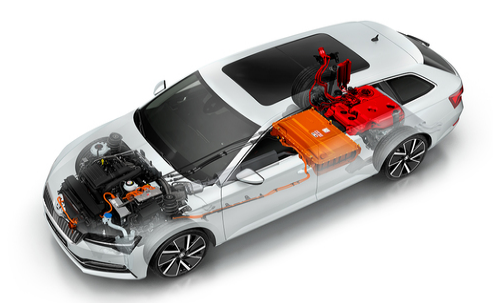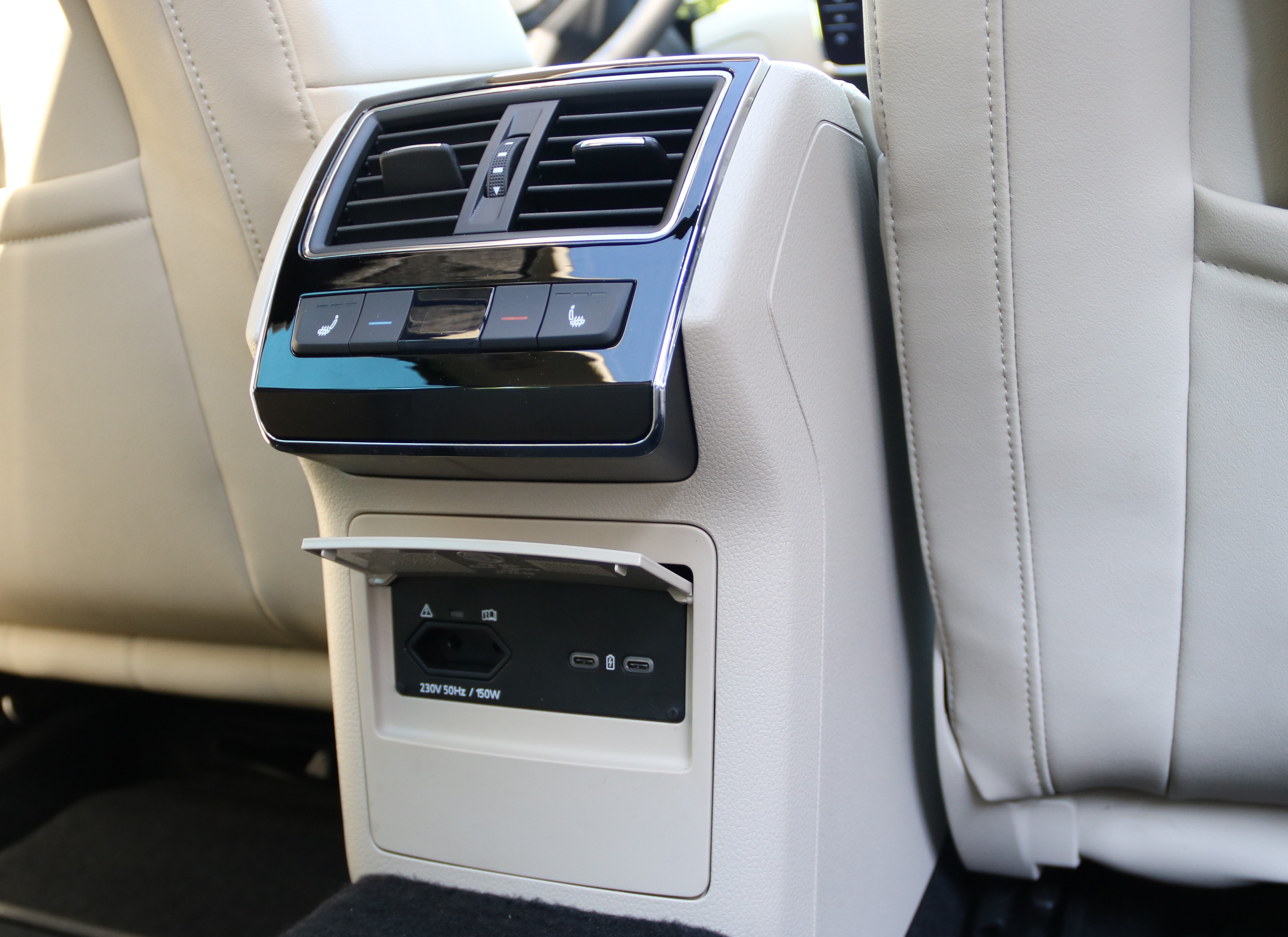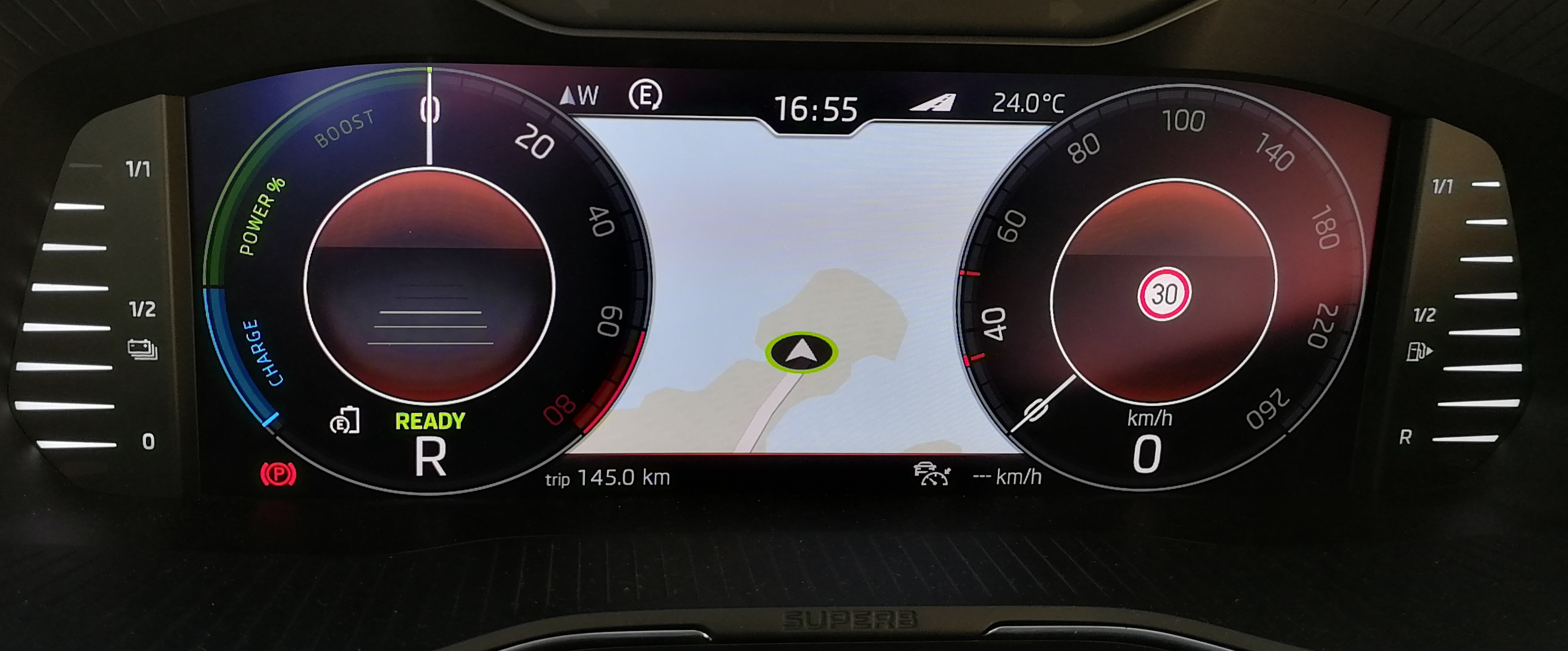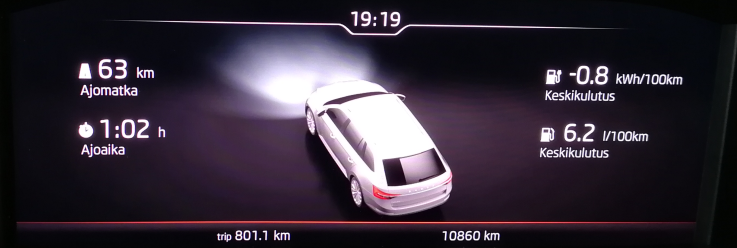The early summer test drive calendar became quite tight as interesting new low-emission rechargeable hybrids are launching into the market at an accelerating pace. The previous test drive took place on Ford's first PHEV, as the Ford Kuga was tested, and now it was time to test Skoda's first rechargeable hybrid, the Superb iV which is visible in the main picture. Admittedly, such a dense test drive was well suited for chartering a schoolboy to a summer pasture, so the hybrid-assisted low-consumption trip promised a clear purpose.
The Skoda iV model series consists of the all-electric Citigoe iV, which is already available, and the Skoda Superb iV model in the article. More Skoda iV model series cars are expected from Skoda in the near future, as by 2025 there should be more than ten iV models. In terms of plug-in hybrids, Skoda will start here at the top of the range, and next up is the Octavia iV, which is a notch smaller. For all-electric cars, next up is the SUV Enyaq iV .
The car was picked up from Espoo, where while waiting a bit I had a good time to snap a few pictures of the car, while also making a general introduction to the car. In addition to Skoda's already abundant equipment, this L&K-equipped model also had the luxury equipment included in the best L&K line, such as chrome moldings on the doors and Skoda texts reflected from the doors to the street. In addition to the standard Superb-style umbrella, the L&K equipment package includes also extra features like e.g. panoramic roof and electrically adjustable front seats, which are also ventilated.
The look of the cab is familiar to Skoda. The Superb model was revamped a little earlier than the Octavia, so instead of the Octavia’s electronic gear selector, the Superb still relies on a traditional gear stick. The car’s center console is controlled by a 9.2 ”Columbus audio and navigation system, which I’ll talk about a little later.
As for the tailgate, the Superb is downright enticing to fill in a clearly lined trunk that looks very big. In terms of dimensions, the boot size is 510 liters (LB 485 l), which is significantly smaller than the 660 liters (LB 625 l) of the normal Superb Combi in terms of dimensions, but at first glance this reduction is hardly noticeable.
At least part of the decrease in measured liters is explained by a fuel tank located below the bottom of the load compartment, which reduces the height so that the normally lowered bottom is at a fixed height in the hybrid.

Photo by Skoda.fi
Often, charging cables lay in the tailgates of charging hybrids, which already hinders the utilization of already slightly shrunk volumes, but Skoda's designers have once again been smart and built a particularly well-suited storage compartment for the charging cables at the end of the boot. From this container, the cables can be accessed with reasonable ease, even if there is already a partial load in the boot.
The almost imperceptible handle placed on the edge of the bumper conveniently reveals the folding towbar.
In addition, there is an even smaller hatch on the edge, behind which you can neatly hide smaller stuff.
In the back seat, attention was drawn to the exemplary large loading hatch, which makes it easier to transport skis or other long objects on four-person trips.
Also striking were the charging plugs that have been now changed to the the USB-C model. One of these was found on the front of the center console and these rear seat plugs in the armrest stand had also been replaced with the c-model connectors.

I was wondering if Skoda is at this forefront in terms of these connectors. Although the latest mobile phones themselves have a USB-C connector, the connectors on the end of the charger are still largely old-fashioned. At least I didn't own a single cable with USB-C connectors on both ends. Immediately on departure, I would have liked to connect my phone via Android Car to Skoda’s center console to get a familiar media and navigation view at my fingertips, so it only helped to pick up a new cable from a local supply store for a staggering € 12.90 price. I say staggering, because usually related accessories can be ordered directly from China, from which a well-informed consumer had ordered for themselves a cable with less money. That could be done e.g. using this advertising link to AliExpress where (at the time of writing) a cable with similar characteristics was sold for € 1.32, including the delivery fee. I would recommend making a cable purchase well in advance, because apparently this transition to the USB-C version is becoming more common, as e.g. According to a Volvo press release, the 12V sockets on the XC60 and XC90 will be converted to USB-C plugs, and BMW will also serve two C-models in the new X1 xDrive25e for rear seat occupants.
So after a flickering cable acquisition, it was time to connect my phone with the center console, after which Android Auto started up without any problems and I got to see the familiar navigation app pre-equipped with my own settings. The audio and navigation system is very modern and has only a few buttons, in addition to which all other control is via the touch screen. Although the view is modern, this does not seem to be the best solution in terms of usability. For example, in the case of my Skoda Octavia, changing between the radio and Android Car can be simply done from separate buttons on the edges of the device, but here Android Auto has to be searched behind a couple of icons and the device feels a bit slow.
The actual test drive was started with a full 13 kWh battery, with hopes for 57 km fully electronic drive, as mentioned on WLTP consumption details as this car's electrical range. This would have been almost enough for me to reach back to my home. Together with a 50-liter petrol tank, a total operating distance of as much as 930 km is promised for the car's operating range. In practice, however, the car switched to hybrid mode at about 42 km mark as the battery had run out earlier than estimated when I pushed the motorway north at 120 km / h. The final consumption for the 58 km journey was 1.6 l / 100 km of petrol and 15.5 kWh / 100 km of electricity at an average speed of 60 km / h.
With the battery still empty, a small 4 km city tour in an area where the speed limit is 40 km / h resulted in consumption figures of 8.5 l / 100 km and 2.0 kWh / 100 km. The seemingly empty battery was thus utilized in regeneration and accelerations.
The next day we left for the summer cottage in a fully loaded car, but a little surprisingly with an empty battery when the settings for my own charging infrastructure had not been in order. As a result, the 77 km distance, which includes a variable section of urban driving, a section of motorway and largest part of normal road conditions, became 5.6 l / 100 km + 1.4 kWh / 100 km at an average speed of 62 km / h. At the summer cottage I then luckily got a car to charge in order to gain some power for the return trip.
While at the cottage, the actual velocity of the boot was also tested with a traditional box test. The area of the tailgate is so large that it can easily accommodate the same four boxes that go in my own Skoda Octavia. In addition to this, the body of the wagon model allows at least one additional box, maybe even another one if both boxes are placed longitudinally on top of the load. However, with the loading shown in the figure the tailgate can't be closed. When the unladen weight of the car varies according to the equipment, between 1730-1861 kg, there is a total weight of 2250 kg, with 389-520 kg to be distributed to passengers and goods.
After a day at the cottage, we were able to leave for the return trip with almost a full battery. Based on the scale showing the charge status of the battery on the left side of the instrument cluster, there was only one bar missing from full charge, which we unfortunately did not have time to wait at this stage. According to the scale of the petrol tank on the right side of the instrument cluster, the tank was still full, even though the car had already been driven a total of 145 km at this stage. Often there is a bit of looseness at that upper end of the scale but I suspect those electrically driven kilometers are affecting the consumption here as well. The digital instrument cluster is included as standard from the Ambition level of Skoda Superb.

According to the trip computer, the return distance, which is one kilometer shorter, was driven with an average speed that was 5 km / h faster than the average speed for the trip to the cottage. This time the average speed was 67 km / h. When the battery was almost full at departure, the consumption dropped to 3.1 l / 100 km and in addition, electricity consumption was 9.7 kWh / 100 km.
Although the evening was already approaching at this point, the intention was to still spend four hours driving as the schoolboy wanted to go to spend the summer at the country side. I had previously watched a video published by Teknikens Värld where the Skoda Superb iV did not succeed in the evasive test, so driving against the evening was a bit questionable due to the increased danger for moose.
On the second Teknikens Vald magazine video the VW group's cousin Passat GTE, which is based on the same MQB-bottom plate fails avoidance test.
After emptying the cottage equipment and reloading the car, we set off immediately. The depot stop was so fast that there was no time left to charge the car, so we embarked on a long journey with a completely empty battery. After 368 km, we reached our summer pastures and recorded statistics of an average speed of 94.8 km / h, with consumption of 6.4 l / 100 km and -0.4 kWh / 100 km of electricity. At this point, that negative electric consumption was a bit thoughtful, but the reading was so small that I didn’t pay any more attention to it. In terms of petrol consumption, the reading was a bit surprising, because the Ford Kuga PHEV of the previous test drive had covered the same distance with a consumption of only about 5 l / 100 km. I remember commenting in the evening that the car had been a little softly swaying, perhaps somewhat reminiscent of a ship, especially with the unevenness of the smaller road to our summer cottage, but the same was also noticeable at some points on the main roads.
As the evening approached for the last hours, the car was left to charge for the night and the driver went to collect his own charge for the next day's return trip. In the morning, I had good time to take a few pictures of the Skoda in the green nature.
In order not to drive back just with an empty car, it was good to dip a little payload into an empty car. When the rear seats were folded down, the Skoda Superb iV turned out to be an actual cargo carrier, carrying as many as eight boxes.
L&K is equipped with Dynamic Chassis Control, an adaptive chassis control system that adjusts shock absorption and steering operation. For the return trip, I chose the Sport mode, which stiffens the car’s suspension to see how it affects the swing mentioned earlier. In my experience, I thought the car’s behavior in Sport mode was clearly better. I was left wondering which had been the DCC settings Teknikens Värld had used on the evasion test video. I read through the comments on the video and there the same thing was considered. Someone also mentioned that he switched the Sport mode to his own key as a standard mode using a personalized setting and I think I'd do the the same for my car.
During the return trip, I tried to follow more closely the charge of the car while driving. On the previous day, the result showed a negative value in terms of electricity consumption, indicating that the battery would have been charged while driving. I noticed that the car not only regenerates power to the battery in more traditional downhill or braking situations, but charging may also occur at some other points. For example, in the situation of the following picture, when driving uphill, the fuel consumption is as much as 20.7 l / 100 km, but at the same time the car is also charging the battery. It’s noteworthy that I drove with the automatic hybrid setting in ECO driving mode, so I didn’t specifically direct the car to charge the battery for later use.

For the return journey, 366 km were covered at an average speed of 92.3 km / h, where petrol consumption was 5.6 l / 100 km and electricity consumption 2.3 kWh / 100 km. A fully charged battery thus dropped the fuel consumption on this trip by 0.8 l / 100 km, but the average consumption is still below the reading of the Ford Kuga. I was left wondering if that was partly due to an unexpected battery charge during the trip.
After a short stop at home, it was time for the last trip as I had to return the car to Espoo. Now I had to drive with an empty battery the same journey I did with a full battery at the very beginning of this story. Here are the results for the trip with an empty battery and at the same time the reference values in brackets for the full battery values. Distance: 63 km (58 miles), with a slight increase in driving in the 40 km / h range this time, but with an average speed of 61 km / h (59 km / h). Consumption is 6.2 l / 100 km (1.6 l / 100 km) of petrol and recharging -0.8 kWh / 100 km (15.5 kWh / 100 km) of electricity.

Prices for the test-driven L&K-equipped Skoda Suberb Combi iV start at € 50,236.16, which is a relatively tough price. The Volkswagen Passat GTE costs € 47,939.43 and my test drive Ford Kuga PHEV from the price was € 41,281.43.
Of course, L & K's model includes a lot of extra, but I might even look at the € 43,510.04 Ambition iV model, for which you can get accessories purchased according to Liisari's site leasing equipment counter for 1454.28 euros for a € 665 usage benefit. By adding a few essential accessories, such as at least a heated windshield and adaptive cruise control, as well as some other accessories, the price of the next Style equipment level is still € 47,067.16. Sure, if the Matrix Led lights want to be included, then Style outfits can make sense. Equipment worth as much as € 1468.57 can also be purchased for it with a € 715 operating advantage. On the other hand, the Skoda Superb iV equipped with Style is very close to the equipment level of the Passat GTE and is only € 872.27 cheaper than the Passat GTE.
In conclusion, I have to admit that expectations for the Skoda Superb iV were perhaps a little higher than what I experienced. In particular, that relatively high consumption was somewhat surprising. On the other hand, as we have seen, consumption over a distance of 60 km can be significantly affected if it is possible to charge the car. The Superb iV is best suited for drivers who need both large legroom and luggage space and who's main journeys are shorter and charging possibilities are available. Generally speaking everything is really at a good Skoda level for the driver and the hybrid performance adds an extra kick for e.g. overtaking. However, according to my driving profile, most of the kilometers come from long distances, so now if I were buying a new car, I would have to seriously consider whether to select the Ford Kuga with a slightly smaller spaces (and a ski box) or to choose Skoda Superb iV and benefit from larger spaces.
One more comment, as the expensive USB-C cable I bought turned out to be a premature purchase when the Superb still had another old USB-A port under the armrest, which would have made Android Car visible. It didn’t help anymore, but as I wrote, the purchase doesn’t seem pointless looking to the future. Later I noticed that the Skoda Rapid I drove for a while didn’t include USB-A model connector anymore.
I also made a short video that you can watch from here.
